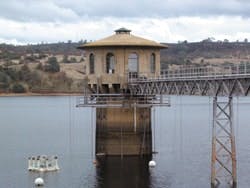Tracking Water Quality
Nestled among the foothills of the Sierra Nevada mountain range, the Pardee reservoir is 100 miles from San Francisco Bay. But this outpost is the crucial origination point for the collection of drinking water that serves 1.3 million residents on the east side of the Bay, including the cities of Oakland and Berkeley.
“Our challenge, but also our silver lining, is our remote location,” said John Johnson, assistant superintendent for water quality at Pardee Reservoir. This silver lining hinges on the reservoir’s location in an undeveloped area with little pollution—a clean 577-mile watershed around the Mokelumne River.
Rain and snowmelt run into the Mokelumne River and flow into Pardee Lake, where the water is stored. From here, it is released into large aqueducts, which transport the water about 90 miles downhill. The aqueduct system is the second crucial point in EBMUD’s network; here, the water is protected from pesticides, agricultural and urban runoff, municipal sewage and industrial discharges.
Controlling Algae with Chlorophyll Data
“Filter cloggers,” which grow naturally in the reservoir and end up at the aqueduct’s terminus, are one of the few water quality issues encountered by Johnson and his staff. These cloggers are usually diatoms, microscopic algae found in the water, and create additional treatment costs before the water can be distributed to customers. The team has begun evaluation of a multiparameter water quality sonde with a chlorophyll sensor from YSI Inc. The tool could provide advanced notice of the presence of or change in diatom biomass, giving EBMUD’s terminal plant operators a heads up for deciding how to deal with the nuisance.
Monitoring chlorophyll concentrations can help control the amount—and expense—of treatment chemicals needed to keep algae levels in check. Johnson says that he is looking for these results and wants to put the technology to full use. The sonde provides additional daily data sets: pH, turbidity, specific conductance, water temperature—all parameters required by the EPA and the state of California.
The level of pH is another critical parameter. End up on the low end of the scale, and the interior linings of the aqueducts could be exposed to corrosion. The readings help the Pardee team determine the amount of lime needed to raise the pH of the naturally acidic water before it enters the aqueduct system.
Protecting Fish by Mixing DO
The Camanche Reservoir, located about 10 miles away, is the third critical point in the watershed protection system. In conjunction with Pardee, Camanche provides flood control and hydroelectric power and serves as a control for irrigation supply in the lower reaches of the Mokelumne River.
The Camanche is part of an important habitat for several fish species. The Mokelumne River Fish Hatchery was constructed at the base of the Camanche Dam in the 1960s to revive salmon, trout and other riparian fish practically wiped out by mining and mine-waste pollution.
Johnson explains that the bottom layer of water in the reservoir, the hypolimnion, is cooler than the surface but also tends to stagnate. “We need to monitor and control dissolved oxygen levels in this layer in order to protect the fish,” Johnson said. Here they use an automated YSI Vertical Profiling System to monitor oxygen levels (as well as several other key water quality parameters) from the top of the reservoir down to the bottom. The profiler gives them a constant supply of vertical data points and helps them decide when to feed liquid oxygen into the lake bottom with a hypolimnatic oxygenating system (HOS). Operation of the HOS is managed and controlled based largely on interpretation of data from the profiler.
The profiler gives Johnson and his staff a detailed picture of the deep reaches of the reservoir where before they only could get a snapshot.“We are saving some serious amounts of labor by using an automated system,” says Johnson. “Our personnel can now collect more data with less work.”
